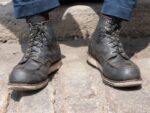No matter what the profession, workplace safety is always of utmost importance. Both the employee and the employer must take all necessary precautions to prevent or safeguard people from occupational hazards or accidents and in such a situation safety gear does play a crucial role.
Be it safety helmets or shoes, each and every safety gear has got its own role to play on the protection front.
If you have been out shopping for safety gear you must have come across metatarsal guards and might have wondered what it was or if it was indeed something necessary.

What are metatarsal guards and what do they do?
One of the most common cause of workplace injuries is rolling or falling objects. No matter how careful you are you just can’t completely avoid the chances of random objects rolling or falling.
So it’s always best to gear up and wear all the necessary personal protection equipment to avoid injuries from such unexpected accidents.
Metatarsal guards are a type of personal protection equipment that will help protect the top of the feet from compression injuries.
If you do not wish to shatter your metatarsals from heavy objects, it is best to protect them with these metatarsal guards.
Metatarsal guards consists of a protective flap that covers the instep area of the feet. The metatarsal guards are indeed extremely essential at construction sites and factories.
What are metatarsal guards?
When there is a risk of injury to the top of the feet, you have to use a protective gear to safeguard your bones from breaking and the metatarsal guards come in handy in such a situation.
The metatarsal bones are the five long bones of the midfoot that connects the toes to the ankle. These bones are prone to breaking and even moderately high levels of compression can break them. So these weak bones do deserve some extra attention and protection.
Metatarsal injuries might take months and years to heal and hence in case of an injury you will not be able to get back to work for a long time, thereby making it a high occupational and economical risk.
These metatarsal guards were introduced to protect your metatarsals, your job and your livelihood. Made with aluminium, steel, synthetic or composite materials, these metatarsal guards will keep your metatarsals from getting crushed.
What are the pros and cons of metatarsal guards?
Metatarsal guards can protect you from heavy objects, solvents, electrical hazards, sharp objects, extreme heat and fractures.
When compared to toe caps they do provide more protection to the feet as they safeguard a larger area of the feet. Metatarsal guards are also lightweight as well when compared to other safety gears that protect our feet.
The only issue with metatarsal guards is that certain types of external metatarsal guards are a bit too heavy and stiff and therefore uncomfortable to wear. Even though they do provide incomparable levels of protection, they can at times result in tripping and falling.
See also: Do I Need a Metatarsal Guard?
Types of metatarsal guards
There are mainly two types of metatarsal guards, namely internal and external metatarsal guards.
External metatarsal guards like a tortoise shell wraps around the boot and protects the feet from metatarsal injuries. They act as a primary level of protection over you boots that provides protection from heavy objects or hot substances.
Since they go on top of your boots you can choose either a thin one or thick one depending on your need or requirement. While wearing bulky external metatarsal guards movement can be a bit uncomfortable or restricted.
It will also be harder to climb ladders with external metatarsal guards on. But you can remove them when you want to move about.
Internal metatarsal guards as the name suggests are integrated into the boot. They provide a layer of protection from the inside of the boot.
Recently internal metatarsal guards have amped up with lighter and thinner metatarsal guards taking into consideration the displeasure of users who found the thicker and heavier older version.
See also: Metatarsal Vs Steel Toe Boots: Which is Most Protective?
Who should use metatarsal guards?
Metatarsal guards are indeed an unavoidable PPE at workplaces that do have the threat of rolling or falling heavy objects.
At construction sites where huge and heavy pipes have to be moved about or when ginormous wheels or barrels of substances have to be rolled around, there is indeed an extremely high risk of metatarsal injuries.
According to a study that was conducted by OSHA, workplaces that handle objects with a median weight more than 65 kgs do have a higher chance of metatarsal injuries happening.
Metatarsal guards are also beneficial in workplaces where there is a chance of spilling or chemicals or boiling liquids.
Will metatarsal guards protect you from electrocution?
Yes, along with providing protection from compression injuries, metatarsal guards also protects you from electrocution. There are metatarsal guards or metatarsal boots with EH protection and static dissipation quality.
Therefore metatarsal guards won’t get you electrocuted but will protect you from electrocution while protecting your metatarsals from injuries.
How to know if your footwear has inbuilt metatarsal guards?
If your boots do have inbuilt metatarsal guards then they will definitely have the label MT. These MT labelled footwear will meet or exceed the ANSI Z41 PT99 standard for Metatarsal Guard footwear.
These types of boots or shoes are specifically designed to protect the wearer from workplace injuries that might shatter one’s metatarsals.
Are metatarsal guards an OSHA requirement?
OSHA requires employers to provide all the necessary personal protection equipment catering to the workplace requirements, to their employees.
The legislation makes metatarsal guards mandatory at workplaces that do possess a substantial risk of a compression or crushing injury to the feet.
Therefore metatarsal guards are indeed an OSHA requirement at workplaces that do deal with the moving of heavy objects.
Should the employer provide metatarsal guards?
OSHA requires the employer to provide all the necessary safety gear to the employees and therefore it is the employer who should provide you with metatarsal guards.
If an employer provides the metatarsal guards and the employee decides to get an upgraded version of the same for better protection, the employer must pay for it.
But if the employer is providing quality product, free of cost and the employee decides to buy another product then the employer do not have to pay for the same.
The employer is indeed responsible for providing the required safety equipment and he/she should also make sure that the employees do have these protective equipment on at all times.
See also: Are Employers Required To Pay For Steel Toe Boots?
Top 3 metatarsal guards
1.) IMPACTO METGUARD METATARSAL PROTECTOR
This heat and electricity resistant metatarsal guards are user friendly with easy straps and suitable for uses in all workplaces.
- Unlike traditional metatarsal guards, the METGUARD is non-conductive for heat and electricity
- Fits all safety shoes and boots with optional attachment straps
- Used with existing footwear and transferable between users and footwear
- Tested to conform with stringent Worldwide Safety Footwear Standards
Prices pulled from the Amazon Product Advertising API on:
Product prices and availability are accurate as of the date/time indicated and are subject to change. Any price and availability information displayed on [relevant Amazon Site(s), as applicable] at the time of purchase will apply to the purchase of this product.
2.) Polycarbonate Safety Footwear Metatarsal Protectors
This durable, lightweight, comfortable and practical metatarsal guards are indeed a perfect option when you wish to stay protected as you walk around your workplace.
- Secured using the laces or straps of the footwear you are wearing, these guards cover the top of the foot to protect the metatarsal bones against physical hazards
- Fits all safety shoes and boots with optional attachment straps
- Practical, comfortable, easy to fit and simple to use
- The met guards are made from durable, non-conductive, lightweight polycarbonate; and can withstand an impact of up to 75 lbs
Prices pulled from the Amazon Product Advertising API on:
Product prices and availability are accurate as of the date/time indicated and are subject to change. Any price and availability information displayed on [relevant Amazon Site(s), as applicable] at the time of purchase will apply to the purchase of this product.
3.) KEEN Utility Men’s CSA Philadelphia 8” Composite Toe Waterproof Metatarsal Guard Work Boots
This durable, waterproof and comfortable work boot comes with great slip resistance and support and unparalleled protection.
- CARBON-FIBER TOE: Left and right asymmetrical, non-metallic carbon-fiber (composite) toes offer unobtrusive fit and are 15% lighter than steel; Meets CSA Z195 Grade 1 standards for toe protection, and ASTM F2412 and F2413M I/75, C/75, MT/75, EH standards
- WATERPROOF: KEEN.DRY is a waterproof, breathable membrane liner, keeping your feet dry and comfortable; Full-grain barnyard resistant waterproof leather helps resist the damaging effects of oleic acid, urea, sodium chloride, and ammonium hydroxide
Prices pulled from the Amazon Product Advertising API on:
Product prices and availability are accurate as of the date/time indicated and are subject to change. Any price and availability information displayed on [relevant Amazon Site(s), as applicable] at the time of purchase will apply to the purchase of this product.










